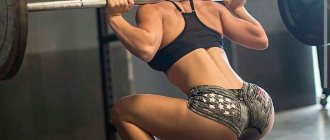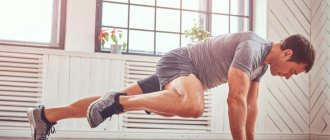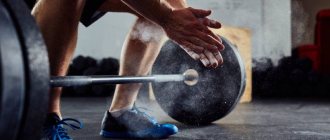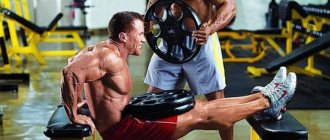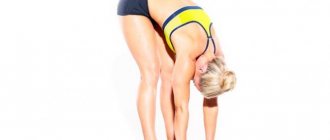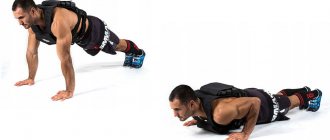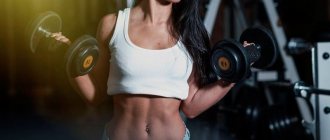It is most difficult for beginners who find themselves in the gym for the first time - they often do the exercises incorrectly, do not know where to start their workout, how to eat properly, what to do to achieve the desired result. A novice athlete may have questions about whether he needs a coach, whether to take a friend with him to training, and what clothes and equipment to choose.
Where to start working out in the gym?
You should start working out in the gym by mastering basic exercises that involve several joints and muscle groups.
In order to work the muscle fibers of the whole body, it is necessary to master and perform the following movements:
- Squats.
- Deadlift.
- Bench press from the chest.
- Barbell row to the waist.
- Pull-ups on the bar.
- Army press.
There are also isolating exercises - exercises that involve only one joint. Some of them will be discussed below.
Concepts
What is the decoding of general physical training, many people know from childhood - this is general physical training. In essence, this is the development of overall strength qualities necessary in sports. Here you gain weight and improve your aerobic potential.
Power can be explosive or absolute. The second option is relevant for representatives of wrestling disciplines, not drums. And they include exercises to develop absolute strength in their general physical training.
Strikers strive to improve their explosive power. It is necessary for the implementation of strong, clear blows and is tied to a specific motor action. And exercises that develop it are included only in the SPP (special physical training) program.
But both explosive and absolute strength depend on the parameters of muscle fibers. For this reason, fighters who are passionate about developing both options include bulking training in their classes. This is already a general physical training program.
Introductory stage of training
The first and most important thing for a beginner is to establish the technique of performing basic exercises and start training.
The first 2 weeks of training should be devoted to practicing basic basic movements:
- Squats.
- Bench press.
- Deadlift.
- Barbell row to the waist.
When developing the movement, it is necessary to use minimal weight, a high number of repetitions and a sufficient number of approaches.
The goal is to accustom the nervous system to perform these movements within the correct technique.
However, the second important factor is stretching, which is necessary to perform the above exercises with “ideal” technique.
Particular attention should be paid to stretching the muscles of the thigh and lower back.
Exercise technique
Squats
Squats with a barbell are the main basic exercise that includes all muscle groups of the legs, with the exception of the legs, and a significant part of the muscle mass of the torso - the back muscles.
This exercise has two main styles of execution:
- Classic squats
- Sumo squats
In the first case, the legs are shoulder-width apart, or slightly wider. In the second case, the legs are spaced wide.
Anatomy of movement:
- The starting position is characterized by bringing the shoulder blades together, raising the chest, bending the lower back inward, abducting the pelvis, and slightly tilting the body forward.
- The barbell is located in the area of the trapezius muscles. As a rule, on the axis of attachment of the posterior bundle of the deltoid muscle. Do not place the barbell on your neck.
- The movement begins with the abduction of the pelvis back, accompanied by the mechanics of movement in the knee joints too.
- You should look up or forward, while keeping your back in its original position.
- It is necessary to squat as deeply as the stretch allows, without distorting the position of the back.
- During movement, the knees should go “to the sides”, along the line of the “toes”; it is allowed to spread the knees a little wider. Bringing your knees inward is strictly prohibited.
- When the angle at the knee joint reaches less than 90 degrees, it is necessary to move the pelvis forward, while maintaining the position of the back, raising the chest.
Classic squats load the quadriceps to a greater extent, while sumo squats work evenly all the leg muscles, giving a significant emphasis on the adductors.
This style of execution reduces the range of motion and allows you to take more weight in a one-repetition maximum while reducing the risk of injury to the back, however, it requires more preparation and stretching than the classic version.
You should master both styles of squats, alternating them periodically. This way the legs will receive a full, harmonious load.
Bench press
The bench press is also performed in different styles. Mainly the differences are in grip. Thus, a wide grip emphasizes the chest to a greater extent, while a narrow grip puts the main load on the triceps.
Let's look at the technique of performing the classic bench press that needs to be developed:
- The torso is located on a horizontal bench: The flattened shoulder blades are tightly rested on the bench, the head and buttocks touch the bench, the heels of the feet are firmly on the floor, there is a deflection in the lower back. The position is similar to the position when performing squats. This is the basic position to be in for most exercises.
- The barbell must be taken so that when it touches the chest, a right angle is formed between the brachioradial and humerus bones. The position must be selected empirically in the process of mastering the movement. Standard grip width is 81 cm.
- The entire body should be tightly fixed in the indicated position.
- The bar is removed from the racks
- As you inhale, the movement of lowering the barbell to your chest begins. During which it is necessary to place your elbows not to the sides or along the body, but along a neutral vector.
- The bar does not descend in a straight line down, but along an arc vector, and touches the lower part of the chest in the solar plexus area.
- As you inhale, the barbell is lifted upward in the same arcing motion.
- The rod is fixed in its original position.
Deadlift
There are also several types of deadlifts.
Let's look at the main ones:
- Classic deadlift.
- Sumo style deadlift.
The differences in styles are exactly the same as with squats.
The principle of movement is similar to that used when performing squats:
- The bar is located on the floor.
- A position is assumed in which the shoulder blades are retracted and the lower back is bent, the hands are placed on the barbell at shoulder width, it is necessary to sit down to the barbell while maintaining the correct position of the back.
- Carry out movement, i.e. lifting the barbell is necessary due to the strength of the legs. The chest should be directed upward, you need to look up. The barbell should touch the tibia of the legs during movement.
- The movement is considered complete when the body is vertical and the legs are straightened at the knee joints.
- It is necessary to return the barbell to its original position by controlling its lowering, without throwing it, in order to avoid injury.
Deadlifts and barbell squats are similar exercises because they target the same muscle groups.
Barbell row to the waist
A movement aimed at developing the back muscles.
It also involves the rear deltoids and biceps:
- The position of the body is the same as when performing a deadlift, however, the difference here is that in the initial position the barbell is in the hands. It is necessary to tilt your body forward, slightly bending your knees for convenience, keeping your back in the correct position.
- Using the strength of your back muscles, bringing your shoulder blades together, pull the barbell towards your waist, bringing your elbows as far back as possible.
- As you lower the barbell, fully spread your shoulder blades to achieve maximum muscle stretch.
Program for beginner men
After two weeks of regularly performing four basic movements, as well as doing stretching exercises for guys, the body should have been more or less prepared for the main part of the training program.
Workout No. 1 (Monday)
| Exercises | Approaches x number of times |
| Squats with a barbell on your shoulders | 4 x 6 |
| Romanian deadlift | 4 x 12 |
| Bench Press | 4 x 10 |
| Pull-ups on the bar with weights, or rows of a vertical block | 5 x 10 |
| Shrugs with a barbell | 5 x 15 |
| Ab crunches on the floor | 3 x 20 |
Workout No. 2 (Wednesday)
| Exercises | Approaches x number of times |
| Deadlift | 4 x 6 |
| Front Squats | 4 x 12 |
| Army press | 4 x 12 |
| Barbell row to the waist | 5 x 12 |
| Bent over dumbbell swings | 3 x 15 |
| Crunches on the floor | 3 x 20 |
Workout No. 3 (Friday)
| Exercises | Approaches x number of times |
| Squats | 5 x 8 |
| Bent-overs with a barbell | 4 x 12 |
| Incline Bench Press | 5 x 12 |
| Dips with or without weights | 3 x 15 |
| Pull-ups on the bar behind the head | 4 x 12 |
| Barbell row to the waist | 3 x 8 |
| Shrugs with dumbbells | 4 x 15 |
| Crunches on the floor | 2 x 25 |
What do you need to know?
As you can see, new exercises are being added:
- The Romanian deadlift is a variation of the deadlift on “straight” legs, with a slight bend in the knee joints. Target muscle group: hamstrings.
- Bend overs with a barbell – an exercise similar to squats, without moving the knee joint, develops the hamstrings.
- Military press – Press a barbell while standing on a vertical axis. Strengthens the muscles of the shoulder girdle.
- Pull-ups on the bar train the back, depending on the grip: behind the head - the upper part, wide - the latissimus dorsi, classic and reverse - the middle and the general mass.
- Barbell/dumbbell shrugs are an exercise aimed at strengthening the trapezius muscles of the back. It represents a shrug along the vertical axis. It is forbidden to perform circular rotations with your shoulders.
- The incline bench press is a variation of the bench press that focuses more on the upper pectoral muscles and the anterior deltoids.
- Dips are an exercise that develops the lower pectoral muscles and triceps.
- Front squats are a style of squatting with a barbell aimed at developing the quadriceps and strengthening the spinal stabilizers. By standing the legs wide, it works the adductor muscles. When performing, the barbell is located on the front bundles of the deltoid muscles and is held with your hands. An auxiliary exercise, useful when adjusting the technique of classic squats with a barbell.
- Bent-over dumbbell swings are an isolating exercise aimed at developing the posterior deltoid muscles.
- Hyperextension is an exercise that allows you to strengthen the muscles of the spinal column, performed on a specialized simulator.
- Floor crunches are a classic exercise for the abdominal muscles.
The principles of performing the above exercises are similar to the basic ones given earlier:
- The weight of the weight is selected such that it is possible to perform the specified number of repetitions with a margin of 1-2 repetitions for a total number of up to 6, and with a margin of 2-4 over six repetitions.
- Rest between sets should not be limited. There are many recommendations on this matter on the Internet. The most optimal indicator is your well-being and readiness to perform the next approach. Between approaches you need to rest as much as your body requires. Typically: 1.5 – 5 minutes.
- The rest between workouts lasts, according to the program, one day , however, a longer rest of no more than three days is allowed.
- If muscle pain on the day of the next workout interferes with its implementation , you should reduce the number of approaches to the corresponding muscle group, or add one day of rest.
- After one to three months, it is necessary to change the training program as follows: Alternating heavy and light training weeks. One week is performed with working weights, 70-80% of the maximum weight in the exercise that the athlete can lift for one repetition, the next week 60%, and then the week 90-95%. At the same time, the number of repetitions in exercises per week with a load of 90-95% is significantly reduced to 1-5. “Refusal” can be used no more than once a week.
- Alternate hard and light workouts. One workout is performed with a load of 70-80%, the next with 60%, and the third with 95%.
Adding Cardio
Circular intensive training can be diluted with cardio cycles. This approach will help diversify your training and prevent a plateau effect. To perform it, you will need to include any cardio-oriented load.
The effectiveness of the technique is due to the fact that running and other cardio exercises are considered energy-intensive. They speed up metabolism, increase glycogen consumption, thereby provoking the body to take energy for restoration from adipose tissue. It is noteworthy that fat continues to burn after exercise for quite a long time. That is why it is worth alternating strength and cardio exercises during circuit training.
Program for beginner girls
The training program for beginner women has the following differences from the men's:
- Less stress on the upper body.
- More stress on the lower body.
- Other exercises.
- More reps.
Where should a girl start in the gym?
The better half should begin a set of exercises by mastering the basic exercises given in the introductory stage, while paying great attention to stretching and cardio training.
Workout 1 (Monday)
| Exercises | Approaches x number of times |
| Squats with a barbell on your shoulders | 4 x 12 |
| Bent-overs with a barbell on your shoulders | 3 x 12 |
| Leg curls in the simulator | 2 x 15 |
| Vertical block thrust | 4 x 10 |
| Bench press | 2 x 15 |
| Hyperextension | 2 x 12 |
Workout 2 (Wednesday)
| Exercises | Approaches x number of times |
| Squats with a barbell on your shoulders | 2 x 8 |
| Romanian deadlift | 2 x 12 |
| Leg curls in the simulator | 4 x 15 |
| Barbell calf raises (or in a machine) | 4 x 12 |
| Barbell row to the waist | 2 x 12 |
| Plank | 2 to failure |
| Crunches on the floor | 3 x 20 |
Workout 3 (Friday)
| Exercises | Approaches x number of times |
| Squats with a barbell on your shoulders | 3 x 10 |
| Leg curls in the simulator | 3 x 12 |
| Leg abductions in the simulator, or on the lower block | 4 x 15 |
| Lunges with dumbbells | 3 x 12 |
| Pushups | 3 to failure |
| Vertical block row for the head | 3 x 12 |
| Calf raises with a barbell or in a machine | 2 x 20 |
| Hyperextension | 2 x 12 |
What do you need to know?
- In this women's training program for girls, exercises for the lower body dominate, while the load on the upper body is minimal. Exercises for the upper part are included to harmonize the figure and maintain the tone of the main muscle groups of the upper part - the back and pectoral muscles.
- It is important to perform cardio at the end of each strength training in the same way as described in the men's program, this will significantly prevent the accumulation of excess weight, and will also develop the cardiovascular system of the body.
- A new course of training and exercises is being added: Leg curls in the simulator - an isolating exercise for the hamstrings.
- Barbell calf raises are an exercise for developing the calf muscles. It can be performed in a special simulator.
- The plank is a static exercise aimed at strengthening the spinal stabilizer muscles, performed for a while by holding it in a stable position, standing on your toes and elbows.
- Leg abduction in the simulator is an exercise that works the adductor muscles of the legs.
- Leg abduction in a machine or crossover trains the gluteal muscles. It is necessary to move one leg back, concentrating the tension in the buttock.
- Lunges with dumbbells are an exercise that comprehensively works both the quadriceps and buttocks. Take a step forward and squat in this position, then take the next step with the other leg. Dumbbells are held hanging in the hands.
- Push-ups are an exercise aimed at working the pectoral, deltoid, and triceps muscles. Analogous to the bench press.
Programs to increase working weight
In “natural” training, i.e. without the use of pharmacological drugs, the redistribution of muscle mass depends on the strength of the osseous-ligamentous apparatus. The thicker and stronger the ligaments, the more muscle mass the body will allow itself to build.
The strength of the ligaments depends on the need for it, i.e. depending on how large the training weight is.
High-threshold fast muscle fibers, which are trained exclusively by strength training, in the repetition range from 1 to 5 with heavy weights, are responsible for the implementation of muscle contraction in a short period of time with maximum effort.
Let's look at several training programs that will help increase working weight in basic exercises.
Program for increasing working weight in the bench press
To increase the working weight in the bench press, you need to perform this movement in every workout, the same goes for all other exercises. At the same time, the specifics of performing the bench press will be radically different.
Let's consider in detail:
| Exercises | Approaches x number of times |
| Bench press | 5 x 8 |
| Bench press | 10 x 15 |
| Bench press | 3 x 3 |
| Bench press | 2 x 12 |
| Bench press | 3 x 6 |
| Bench press | 4 x 15 |
| Bench press with pause | 5 x 5 |
| Bench press | 4 x 15 |
| Bench press | 2 x 2 |
| Bench press with pause | 3x10 |
| Bench press | 4 x 12 |
| Bench press | 4 x 2 |
| Bench press | 4 x 15 |
| Bench press | 4 x 20 |
In this case, microperiodization is used, which has a beneficial effect on the development of the nervous system and an increase in strength indicators in this exercise. The numbers indicate the workouts themselves, which are performed after 1-3 days; they can be combined with training for other muscle groups.
Program for increasing working weight in deadlift
Deadlifts and squats with a barbell are similar exercises, so programs for increasing working weight in these movements will be similar:
| Exercises | Approaches x number of times |
| Deadlift | 3 x 12 |
| Squats | 4 x 6 |
| Deadlift from the pit 40% of maximum | 4 x 10 |
| Deadlift 60% of maximum | 5 x 12 |
| Deadlift from plates 100% of maximum | 3 x 6 |
| Barbell squats 60% | 4 x 10 |
| Deadlift 80% | 5 x 5 |
| Deadlift from the pit 30% | 10 x 10 |
| Deadlift 85% | 3 x 5 |
| Barbell squats 75% | 4 x 8 |
| Deadlift from the pit 40% | 10 x 10 |
| Deadlift penetration | Up to 1 rep with maximum weight |
Program for increasing working weight in squats
| Exercises | Approaches x number of times |
| Squats | 3 x 12 |
| Deadlift | 4 x 6 |
| Paused barbell squats with a weight of 40% of the maximum | 5 x 10 bent over barbell 3 x 12 |
| Front Squats | 3 x 10 Romanian deadlift 3 x 10 |
| Squats | 3 x 3 |
| Deadlift | 5 x 15 |
| Squats | 2 x 15 |
| Deadlift from plates | 3 x 3 |
| Squats | 4 x 8 |
| Front Squats | 5 x 3 Romanian deadlift 3 x 8 |
| Squats | 2 x 12, pit deadlift 2 x 10 |
| Squats | 6 x 6 |
| Deadlift | 6 x 6 |
| Paused barbell squats | 4 x 8 (40%) |
| Paused barbell squats | 1 x 10 (30%) |
| Squat walk | up to 1 repetition with maximum weight |
- The program should include training once every two weeks with a weight of 95% of the maximum and above.
- It is necessary to include light training to develop movement and train the central nervous system.
- It is necessary to add “auxiliary” exercises, such as “bench press with pause”, “squats with pause”, “deadlift from the pit”, “bench press from a bar (pressure)”, “half squat”, “deadlift from the block » - to overcome “dead zones” when driving.
- All approaches are not performed to failure. When performing an exercise, you should leave 1-2 repetitions in reserve in the case of training for a low number of repetitions, and about 5 repetitions when training for a high number of repetitions. This will help avoid central nervous system fatigue.
What is circuit training
Circuit training is high-intensity training of all muscle groups in a short period of time. As a rule, 6-7 exercises are performed in 1 circle. Each is performed at an accelerated pace, and the rest between exercises is 30-40 seconds.
Circuit training stimulates the release of stress hormones:
- adrenalin;
- norepinephrine;
- cortisol
It is these “guys” that are responsible for increasing glycogen consumption and accelerating lipolysis (the breakdown of fat cells into energy).
In order for the hormonal surge to last, you need to train in a high-intensity mode. But regular cardio, running or an exercise bike, will not allow you to keep the bar high. Therefore, circuit training uses strength exercises that are performed in an aerobic mode.
Programs for the mass of individual muscle groups
Let's look at simple training schemes for the development of specific muscle groups, which can be combined with each other either by working out the whole body in a workout or by a split program, or added to an existing training plan.
Abs training program
Workout 1:
| Exercises | Approaches x number of times |
| Crunches on a vertical block (“prayer”) | 4 x 8 |
| Hanging leg raises on bars/bars | 4 x 15 |
| Crunches on the floor | 2 sets to failure |
Workout 2:
| Exercises | Approaches x number of times |
| Crunches on the floor | 3 x 20 |
| Hanging leg raises to the sides (for oblique muscles) | 2 x 15 |
| Twisting on a vertical block (“prayer”) with body turns (on the oblique muscles) | 4 x 12 |
Workout 3:
| Exercises | Approaches x number of times |
| Crunches on a vertical block (“prayer”) | 3 x 10 |
| Twisting on a vertical block (“prayer”) with body turns | 3 x 10 |
| Leg raises while hanging straight and with body turns (on the oblique muscles) alternately | 3 x 15 |
| Plank | 2 sets for maximum time |
Shoulder training program
Workout 1:
| Exercises | Approaches x number of times |
| Army press | 3 x 8 |
| Swings with dumbbells | 2 x 12 |
| Bent over dumbbell swings | 2 x 12 |
| Pull a horizontal block to the chin | 2 x 15 |
Workout 2:
| Exercises | Approaches x number of times |
| Swings with dumbbells | 3 x 15 |
| Bent over dumbbell swings | 2 x 15 |
| Barbell row to the chin | 2 x 15 |
Workout 3:
| Exercises | Approaches x number of times |
| Bench press | 2 x 6, 2 x 10 |
| Pull a horizontal block to the chin | 4 x 12 |
| Swings with dumbbells | 2 x 8 |
Chest muscle training program
Workout 1:
| Exercises | Approaches x number of times |
| Bench press | 3 x 6 |
| Incline Dumbbell Flyes | 3 x 8 |
| Bringing the hand on the lower block | 2 x 12 |
Workout 2:
| Exercises | Approaches x number of times |
| Dips with weights | 4 x 12 |
| Push-ups with feet elevated | 2 to failure |
| Dumbbell flyes on a horizontal bench | 2 x 15 |
Workout 3:
| Exercises | Approaches x number of times |
| Incline Barbell Press | 3 x 10 |
| Pushups | 2 to failure |
| Bringing the hand on the lower block | 2 x 15 |
Leg training program
Workout 1:
| Exercises | Approaches x number of times |
| Squats | 4 x 8 |
| Romanian deadlift | 2 x 12 |
| Barbell calf raises | 4 x 16 |
Workout 2:
| Exercises | Approaches x number of times |
| Deadlift | 2 x 10 |
| Front Squats | 4 x 12 |
| Barbell calf raises | 3 x 8 |
Workout 3:
| Exercises | Approaches x number of times |
| Barbell squats 60% of maximum weight | 5 x 8 |
| High jump | 3 x 10 |
| Single leg calf raises with kettlebell | 3 x 12 |
| Superset of leg bending/extension in the simulator | 3 x 25 |
Workout 4:
| Exercises | Approaches x number of times |
| Squats | 5 x 5 |
| Bent-overs with a barbell | 3 x 12 |
| Barbell calf raises | 2 x 10 |
Workout 5:
| Exercises | Approaches x number of times |
| Deadlift from the pit | 4 x 12 |
| Barbell squats 40% of max weight | 6 x 8 |
Trapezius training program
Workout 1:
| Exercises | Approaches x number of times |
| Shrugs with a barbell | 4 x 12 |
| Army press | 3 x 10 |
| Shrugs with dumbbells | 3 x 20 |
| Lee Haney Deadlift | 3 x 15 |
Workout 2:
| Exercises | Approaches x number of times |
| Seated overhead press | 3 x 6 |
| Bent-over dumbbell shrugs | 3 x 12 |
| Bent-over barbell row with a pause at the top point | 3 x 10 |
| Vertical block row for the head | 3 x 15 |
Workout 3:
| Exercises | Approaches x number of times |
| Army press | 2 x 15 |
| Shrugs with a barbell | 3 x 10 |
| Bent-over dumbbell shrugs | 4 x 15 |
Butt training program
Workout 1:
| Exercises | Approaches x number of times |
| Squats | 4 x 12 |
| Romanian deadlift | 3 x 8 |
| Leg abductions in the simulator | 3 x 15 |
Workout 2:
| Exercises | Approaches x number of times |
| Deadlift | 3 x 8 |
| Lunges with a barbell | 4 x 12 |
| Bent-overs with a barbell | 3 x 10 |
| Barbell squats 60% with pause | 3 x 6 |
Workout 3:
| Exercises | Approaches x number of times |
| Squats | 3 x 6 |
| Pelvic adduction from a lying position with weights | 4 x 12 |
| Romanian deadlift | 3 x 10 |
| Leg abductions in the simulator | 3 x 15 |
Triceps training program
Workout 1:
| Exercises | Approaches x number of times |
| Close grip bench press | 3 x 8 |
| Dips | 3 x 12 |
| Arm extensions on a vertical block | 4 x 15 |
Workout 2:
| Exercises | Approaches x number of times |
| French press | 4 x 15 |
| Close grip push-ups | 3 x 15 |
| Bent over arm extension with dumbbell | 3 x 15 |
Workout 3:
| Exercises | Approaches x number of times |
| Close grip bench press | 2 x 6 |
| Arm extensions on a vertical block | 3 x 12 |
| Close grip push-ups | 2 to failure |
Biceps training program
Workout 1:
| Exercises | Approaches x number of times |
| Bent-over barbell row | 4 x 6 |
| Barbell curl | 3 x 10 |
| Hammers | 4 x 12 |
Workout 2:
| Exercises | Approaches x number of times |
| Pull-ups on the bar | 3 x 12 |
| Hammers | 4 x 15 |
| Crossover curls | 3 x 10 |
Latissimus dorsi training program
Workout 1:
| Exercises | Approaches x number of times |
| Wide grip pull-ups | 4 x 6 |
| Horizontal block thrust | 3 x 12 |
| Bent-over dumbbell row with one hand | 2 x 15 |
Workout 2:
| Exercises | Approaches x number of times |
| Bent-over barbell row | 5 x 12 |
| Wide Grip Vertical Row | 5 x 15 |
Workout 3:
| Exercises | Approaches x number of times |
| Bent-over T-bar row | 2 x 10 |
| Bent-over row in the lower block | 4 x 15 |
| Classic pull-ups on the bar | 2 sets to failure |
Regulatory block
Each age group and category of athletes has its own standards that must be achieved. In other words, these are standards.
For example, high school students must cover 100 m in 13.8 or 14.2 seconds (these are grades above 3). The norm for boxers at a similar distance is 12.2 and 12.5 seconds. These are indicators for ratings 5 and 4, respectively.
3 km run. For schoolchildren the norm is 12.2 and 13 minutes. For boxers: 10.21 and 10.57 min.
Pull-ups on the horizontal bar: final grade schoolchildren – 14 and 11 times. Boxers: 31 and 24.
General programs for gaining muscle mass
There are many “typing” programs, the most effective ones are listed below.
The best program for gaining muscle mass
Let's consider the ideal training program for gaining muscle mass.
Workout 1:
| Exercises | Approaches x number of times |
| Bench press | 4 x 3 |
| Squats | 5 x 5 |
| Bent-overs with a barbell | 2 x 8 |
| Weighted pull-ups | 5 x 5 |
| Army press | 3 x 8 |
Workout 2 (the very next day):
| Exercises | Approaches x number of times |
| Squats with a barbell with a pause of 40% of the maximum weight | 4 x 8 |
| Close grip bench press | 3 x 10 |
| Barbell row to the waist | 2 x 12 |
| Crunches on the floor | 3 x 20 |
| Hyperextension | 3 x 12 |
| Standing calf raises | 4 x 12 |
Workout 3 (every other day):
| Exercises | Approaches x number of times |
| Deadlift | 3 x 8 |
| Bench press | 3 x 8 |
| Front Squats | 2 x 10 |
| Vertical block thrust | 4 x 12 |
| Bent over dumbbell swings | 3 x 12 |
Workout 4 (the next day):
| Exercises | Approaches x number of times |
| Leg extensions in the exercise machine (pumping style) | 3 sets in the middle of the amplitude of 40 seconds of slow movement with a rest of 20 seconds between sets |
| Crunches on the floor | 2 x 15 |
| Standing calf raises | 4 x 10 |
Workout 5 (every other day):
| Exercises | Approaches x number of times |
| Bench press | 4 x 12 |
| Squats with a barbell on your shoulders | 4 x 8 |
| Army press | 2 x 10 |
| Pull-ups | 4 x 8 |
| Superset: Dumbbell swings x12 + shrugs x15 | 4 approaches |
Workout 6 (the very next day):
| Exercises | Approaches x number of times |
| Pause squats 50% of maximum weight | 4 x 10 |
| Standing block row with emphasis on the rear delts | 4 x 12 |
| Abdominal training on a pulley (pulley) | 3 x 12 |
| Plank | 2 to failure |
Antagonist muscle training program
There is such a split scheme option as training antagonist muscles. It consists of training opposite muscles in one day.
For example:
- Monday: deltoids, arms (biceps/triceps/brachialis/forearm muscles)
- Wednesday: Legs (quadriceps/hamstrings/glutes/adductors/calves)
- Friday: chest, back.
In this case, for natural training, this option will be effective for the arms and deltas, since these muscle groups will be included in the work both on Monday and Friday, with basic exercises for the back and pectoral muscles, but the remaining muscle groups will grow highly doubtful.
Let's create a split program as follows:
Monday:
| Exercises | Approaches x number of times |
| Bench press | 4 x 6 |
| Army press | 4 x 8 |
| Incline Dumbbell Flyes | 3 x 12 |
| Barbell row to the waist | 4 x 8 |
| Pull-ups | 4 x 12 |
| Shrugs | 4 x 15 |
| Swings with dumbbells | 3 x 12 |
Tuesday:
| Exercises | Approaches x number of times |
| Squats | 5 x 5 |
| Romanian deadlift | 4 x 10 |
| Front Squats | 4 x 12 |
| Standing calf raises | 4 x 12 |
Thursday:
| Exercises | Approaches x number of times |
| Incline Bench Press | 4 x 12 |
| Close grip bench press | 4 x 8 |
| Vertical block row for the head | 4 x 10 |
| Wide grip pull-ups | 4 x 8 |
| Bent over dumbbell swings | 3 x 12 |
| Shrugs | 4 x 10 |
Friday:
| Exercises | Approaches x number of times |
| Deadlift | 4 x 8 |
| Lunges | 3 x 12 |
| Pause squats with a weight of 50% of maximum | 4 x 8 |
| Superset of leg bending/extension in the simulator | 3 x 15 |
| Calf raises | 4 x 12 |
Small, high-quality meals
It's not that simple. Nutrition is no less important than sleep. Go.
Train yourself to eat 6-8 times a day! This is necessary to speed up your metabolism (metabolism). You will be able to get more from your food. The body will absorb nutrients better! If you starve, you won’t get pumped up! I'm telling you exactly!
Remember that there are two phases in bodybuilding! The muscle mass gain phase and the cutting phase (anabolism and catabolism, respectively). Combining these two phases is impossible! Either you're bulking up or you're drying out! If there is no muscle mass, then there is no point in drying out!
Sample diet for building muscle mass:
- Meat (any), chicken, fish about 500 g per day
- Milk (about 300-500 g), eggs (6-10 pcs), cottage cheese (200 g), kefir (300 g).
- Rice, Buckwheat, potatoes, vegetables (fresh, boiled, etc.) approximately 500 g.
- Drink plenty of water! I talked about this in this article. During training and throughout the day! At least 2 liters per day! Remember, minimum! Buy yourself a shaker (250-500 rubles). Pour water into it and drink while studying, at home, or while training. Everywhere! The bigger, the better! There is never too much water.
By the way, I posted a lot of cool and simple recipes in an article about protein shakes at home for a set. There are protein shakes for weight loss that you can easily prepare at home.
Understand that to become bigger you need to get out of your comfort zone. Those. you won’t be able to eat either! We need to eat more! To trigger high-quality anabolism, you must eat a lot, i.e. there must be a calorie surplus! Belly fat, etc. may even appear. It's all bullshit! It will all go away quickly during drying! Moreover, the more muscle there is, the faster it will burn!
For example, like this:
- 07:40: Drank a mug of water
- 8:00: Ate oatmeal, cheese sandwich, 2 eggs.
- 10-11 o'clock: A piece of chicken, an egg, rice.
- Lunch: Chicken or meat, rice, vegetables, egg, washed down with milk.
- After school or work, before training (15-16 hours): vegetables and a couple of eggs, so as not to overload and not have a hard time, or, better yet, drink a protein shake! Delightfully digestible and very useful!
- After the workout, we ate meat, vegetables, a couple of eggs, milk (carbohydrates, such as rice, etc., are better not worth it, they will go into fat and the body won’t have time to use them up).
- Before going to bed (at night): a pack of low-fat cottage cheese (200 g) and a mug of kefir! Recommendation: buy cottage cheese no cheaper than 45-50 rubles, otherwise you will simply eat coconut fat or other contamination.
- Plus, take some multivitamins!
The basic circuit will look something like what I indicated above.
You will find this difficult! Naturally! It is not simple! But I’ve been eating this way for a very long time and it’s bringing results! This must be hard! That's the whole point! To get bigger, you have to eat more and progressively lift!
To become something you haven’t been, get ready to do something you haven’t done!
You can vary the products differently, don’t be afraid! The main thing is to eat more often! 6-8 times will be great! Just opened the vacuum container, ate a couple of pieces of meat with cucumber and it was fine). Then a little more!
Massive program for experienced athletes
- Actually, there are no differences in terms of gaining muscle mass and pumping, however, in terms of increasing strength indicators, there are differences.
- Having reached the genetic limit, it is very difficult to “break through” strength indicators, however, it is possible.
- The first method, the use of anabolic steroids, should not be considered, since their use is permissible only in professional sports.
- But the second method is used by both “natural” athletes and “professionals”, this is macroperiodization.
- The bottom line is that we significantly reduce working weights by performing a series of light workouts over several months, gradually approaching the previous strength indicators.
During such “detraining,” the body becomes disadapted to the training process, which causes it to experience habitual, past stress as potentially strong and new, which leads to a corresponding response in the form of a gain in muscle mass and an increase in strength indicators.
- Week 1 – daily training according to the program from the introductory stage.
- Week 2 – similar, but with a weight of 40% of the maximum.
- Week 3 – weight 50% of the maximum, training every other day.
- Week 4 – weight 60% of the maximum, the number of repetitions is reduced by 2.
- Week 5 – 70% weight, the number of repetitions is reduced by 1 sets per 1.
- Week 6 – 80% of the maximum, the number of repetitions is reduced by 2 sets per 1.
- Week 7 – 85%, the number of repetitions is reduced to 4, sets to 3, squats and deadlifts alternate.
- Week 8 – 90% of the maximum, the number of repetitions is reduced to 3, sets to 2.
- Week 9 – 92.5% – same intensity.
- Week 10 is an easy week, similar to week 6, two workouts per week.
- Week 11 – 95% – 2 reps, 2 sets, two workouts per week.
- Week 12 is an easy week similar to week 6, three workouts per week.
- Week 13 – 97.5% – 2 reps, 4 sets – one workout per week, two workouts similar to week 4.
- Week 14 – similar to week 5.
- Week 15 – 100% of previous maximum reps 3, sets 2.
Further, it becomes clear that the previous weights are much easier, provided that the volume of training is small. You should move forward very slowly, adding minimal weight.
There can be many options for macroperiodization. This program is designed to increase strength indicators, which will lead to growth of muscle mass. Similar training schemes are used in powerlifting.
You can dilute the training program with pumping exercises and cardio training. It is allowed to count not from the maximum weight, but from the working weight.
Mass program: impact on muscle growth factors
Training:
- Pumping training with light weights is carried out the next day after classical strength training, or on the same day after it.
- Once every two weeks, it is necessary to perform heavy strength approaches in the bench press, squats and deadlifts for 1-3 repetitions with a weight of 90-100% of the maximum.
- Only pumping approaches are performed to failure.
- The frequency of training should be at least once every four days. It is most advisable to train the entire body during a workout using almost only basic exercises.
Other:
- Sleep at least 8 hours a day.
- Adequate nutrition: 1.5 g of protein, 3.5-4 g of carbohydrates, 0.6-1 g of fat per 1 kg of body weight. Fortification
- Minimizing bad habits.
- Reducing stress levels in everyday life
The main factor is high testosterone levels, which are maintained by getting enough sleep and consuming enough saturated fatty acids.
Regular exercise also stimulates testosterone secretion. Alcohol and nicotine reduce testosterone levels, while caffeine blocks its synthesis for a period of about six hours.
Nervous experiences and stress stimulate the release of stress hormones such as cortisol, adrenaline, norepinephrine, which are testosterone antagonists. Excessive levels of stress force the body to expend its own energy resources beyond measure, which leads to exhaustion and overwork of the nervous system, which also affects testosterone levels.
What you need to burn fat
For an effective fat burning process, you will need to follow several rules, thanks to which the female figure will acquire the desired slimness:
- proper nutrition and drinking regime;
- high-intensity aerobic training;
- schedule.
A balanced diet is important in the process of burning fat tissue. Proper nutrition for weight loss is characterized by an emphasis on the intake of proteins and cutting carbohydrates. The frequency of meals is around 5-6 times a day. The body should not feel hungry, otherwise it will store fats in reserve. It is also important to stay hydrated, as water helps remove toxins from the body.
Training takes place from 3 to 5 times a week. They should take no more than 60 minutes in duration. The main criterion for a successful workout is maintaining a cardio regimen. The heart rate should be between 115 and 135 beats per minute. It is within this heart rate that the body releases hormones that burn fat.
Daily routine is the final factor involved in fat burning. Modern rhythms of life do not allow relaxation. Snacking on the go, working until late, constant stress - all this does not allow the body to speed up its metabolism so that fat burning occurs. A good idea would be to go to bed and get up at the same time. Sleep – 8 hours a day.
Common mistakes made by newbies
Let's look at the main mistakes that gym goers who do not have the proper experience most often make and tips on how to correct the situation:
- Trying to lift too much weight without mastering the technique of the exercise. This mistake is the most serious because it can lead to severe injuries. Working weights should be increased gradually, having first fully mastered the technique of performing the exercises.
- Neglecting basic exercises in favor of isolating exercises. This error is visible in every gym. Young guys often grab dumbbells when performing biceps curls, mistakenly believing that this will lead to increased muscle mass in their arms. However, this can only lead to a waste of time. The muscle mass of both the arms and the whole body will increase along with the increase in strength indicators in basic exercises for large muscle masses.
- Working out a muscle group less than once every four days. When training without the use of anabolic steroids, muscle growth zones are open for two days after strength training, therefore regular stimulation of muscle fibers is necessary, preferably every other day, and ideally every day. To avoid overtraining with this training regimen, it is necessary to train low volume and low intensity, inserting heavy training once or twice a week.
- Short rest between sets. If you follow common recommendations and rest only 40 seconds between sets, this will lead to excess accumulation of lactic acid, which will destroy muscle tissue. A short rest is only advisable in case of pumping when training slow muscle fibers. During standard strength training, rest should be from 1.5 to 5 minutes, depending on the working weight, the number of repetitions and the characteristics of the body.
- Inadequate nutrition and sleep. Very often, gym goers are “undernourished,” which prevents them from effectively gaining muscle mass, although they feel like they are consuming a lot of food. For accuracy, it is advisable to count the consumed amount of proteins, fats and carbohydrates, then the reason for stopping muscle mass gain will most likely become clear.
Features of circuit training
One of the striking features of circuit training is performing any exercise at a high tempo or for a while. Good examples can be seen in CrossFit routines, and the Tabata protocol can also serve as an excellent example of interval training.
Advantages
There are a number of advantages to this type of training:
- effective burning of fat tissue;
- increase in strength and endurance;
- helps give the body definition;
- short training sessions;
- ability to work with both fixed and free weights.
Flaws
Almost every set of exercises has disadvantages, and this technique also has its fly in the ointment:
- high load on the heart muscle;
- does not help build muscle mass;
- in small halls with a lot of visitors it is not always possible to work without interruption.
Bottom line
The desire for quick results often leads to disappointment at best, and injury at worst. To achieve your goal, you must be willing to work hard day after day, systematizing and analyzing your training process, regimen and lifestyle.
Patience and regular weight training, while following the principles outlined in the article, will over time lead to a gain of high-quality and functional muscle mass.
Alexandrova Anastasia
Nutrition and healthy lifestyle specialist and author of myfitnesblog.com. For many years, she has successfully helped women and men lose weight and maintain a beautiful figure.
